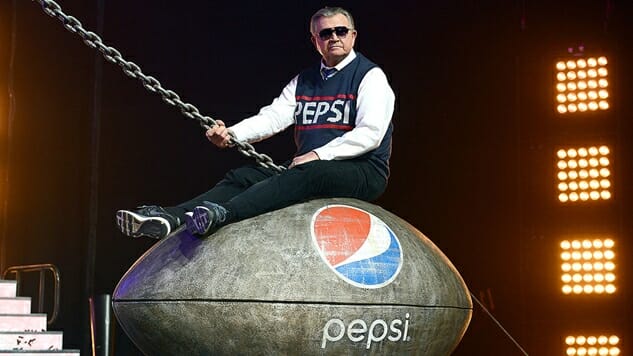Buzz and Backlash: A Short History of Pepsi’s Bleeding Edge Controversies
Photo by Mark Davis/Getty
It was a train wreck of epic proportions from beginning to end. Reality star/supermodel Kendall Jenner tosses her blonde wig at her African American assistant, and after a series of cringeworthy vignettes hands a Pepsi to a riot policeman who takes a sip and appears to have a moral epiphany right there on the street.
Mercifully, Pepsi pulled the ad the day after it dropped. Nevertheless, it will still go down in history as yet another one of Pepsi’s controversial headline-grabbing attempts to get a moment in the spotlight typically occupied by arch rival Coca-Cola and more recently LaCroix. Pepsi has been doing this type of quick hit controversial and topical ad for more than 20 years. Previous Pepsi disasters have included Madonna’s 1989 ad featuring imagery that offended Catholics everywhere. Pepsi also tried pairing Britney Spears and Bob Dole in another big budget production essentially consisting of men all over the world, including Dole, (who had become notorious at the time for his role as the Viagra spokesman) ogling the twenty year-old pop princess. But this time instead of simple garden-variety controversy, Pepsi managed to trivialize nearly every issue facing the country—not to mention nearly every religious and minority group.
How did everything go so terribly wrong this time? Advertising executives and branding specialists speculate it was probably a combination of “creative by committee,” a lack of diversity among the in-house team trying to ride the wave of resistance sweeping the country without making any attempt to understand what that resistance is fundamentally about. Many of the industry’s creative and branding professionals suspect the development of this ad went down in a way very similar to the clueless director SNL parody of the original ad.
“I don’t imagine their conversation went ‘Hey guys, we’re gonna do a political protest ad and piss a bunch of people off,’“ says Kristoffer Roxas CEO, Hxnesty Media House in Vancouver whose clients include Toyota, Android and Cadillac. “It probably went more like ‘Okay, we need to create an ad that appeals to SJWs [Social Justice Warriors] and all the political issues in America.’ Their ad seemed like it lacked a little bit of preparation and foresight. But, at the end of the day, we’re all still talking about Pepsi.”
“I’m not part of the Pepsi team, so I can’t say this for sure, but I think they have a faster and looser policy when it comes to marketing, “ Roxas says. “Coke has always been the top dog, so they play defense and run safe ads. Pepsi has always been the underdog, so the play offense and are willing to be more controversial to get more market share.” Number two always has to try harder, and Roxas says the basic strategy is a good one because they need to be aggressive if they want to drive growth. But he warns that an aggressive stance comes at a price. “When you’re going to push the envelope, you might slip up, like now with Kendall Jenner.”
Roxas points out that Pepsi has a history of signing controversial celebrities. I don’t think they did this on purpose. I think they’re just tragically fated,” he says. “Both Coke and Pepsi sign a lot of celebrity endorsements, but the difference is that Pepsi’s always trying to up the ante and take more risks to get big names. When Coke and Pepsi were fighting for Michael Jackson in the 80’s, Coke was concerned that Michael would only bring in the African-American market. Coke offered him a $1 million dollar deal. Pepsi, offered a $5 million dollar deal and said he was ‘bigger than God.’”
In 1989, Pepsi paid another $5 million to hire Madonna as their next megastar musical spokesperson. What Pepsi failed to realize is that when it hired Madonna, it hired all the controversy over the sexual innuendo and religious imagery constantly swirling around her. Pepsi’s ad featured a pleasant enough version of Madonna’s then-hit single Like A Prayer, but a day later, she released her own video for the song that was filled with enough racy and religious content to shock Christian religious groups all over the world. Facing a boycott, Pepsi pulled that ad almost immediately and ended its relationship with Madonna, (who is still bitter about the incident, by the way.)
Matt Lester, executive creative director at Peppercomm in New York City, previously worked on the Coke team during his 30 years at McCann Erickson and knows fighting the Cola Wars is not for beginners. “Michael Jackson, Madonna, David Bowie, Shaq and so many, then relevant, celebrities convinced us all that Pepsi was the rebel brand to Coca-Cola’s classic reputation,” he says. ”’The taste of a new generation?’ That’s a pretty brilliant line for a challenger brand to relate to its teen consumer base.” Lester says that by maintaining its image as an edgy rebellious brand, Pepsi was true to its brand DNA and that forced Coke to stay true to its brand DNA. “In the end, they both benefited from this at times symbiotic relationship.”
Lester says that Coke learned over the years how to play strong defense to Pepsi’s edgy offensive challenges. “There was a very simple, yet golden rule—a filter—for every single script that we presented to Coke. If you could replace the Coke can in the scene with a can of Pepsi, or any other product for that matter, the narrative should simply fall apart.” He cites Coke’s famous 1971 Hilltop ad as an example. “No other brand at the time it was produced could have done the that spot. Coke was the only truly global soda, sold to more nationalities than any other brand at the time. It’s Ironic that Pepsi actually used the phrase, “…in the spirit of harmony” in their press release defending their incredibly tone-deaf spot.”
The accidental fallout from Pepsi’s ads seem to create more buzz than the ads themselves, but experts believe the faux pas are unintentional. David Burrows of the M&M Agency in Dallas thinks that ‘campaign by committee’ could also be responsible. “One problem is that big brand campaigns are created in silos and cooked up from big data and analytics which used alone, point executives to graphs and charts highlighting which celebrity should be chosen, what theme should be scripted and what are the stories and characters within the campaign,” he says. “This approach always leads to a clunky and awkward pitch of blending the brand with whatever is trending at the time while ‘whitewashing’ the message so to keep it inoffensive and generic.” But somewhere along the line what was intended to be a generic feel good spot turned into what Burrows called “chalkboard screeching.” “The only way it could have been more uncomfortable would be if it were directed by [White House senior advisor Steve] Bannon.”
The consensus is that Pepsi’s strategy is good, but the execution was a disaster. “Even a well known brand needs to find innovative and fun ideas to remain a part of the cultural conversation, and attract new fans,” says Mandy Menaker, head of public relations and brand development at Shapr (cq) in New York City. Menaker thinks a lack of outside input into the spot’s development is probably a key factor in its ultimate tone-deaf failure.
-

-

-

-

-

-

-

-

-

-

-

-

-

-

-

-

-

-

-

-

-

-

-

-

-

-

-

-

-

-

-

-

-

-

-

-

-

-

-

-








































